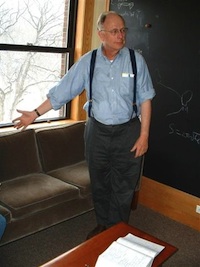
Who's looking at you?
View from the inside or the outside?
"Observers, of course, are important in all of physics," says Jim Hartle, Professor of Physics at the University of California, Santa Barbara. This is because predicting, making and comparing observations is fundamentally how physics is done. We (or rather, our fellow human physicists) use theories to predict what our observations will be and we test these theories by checking if the observations that are predicted match what we actually observe.
An observer doesn't necessarily have to be a human being, says Hartle, they just need to be what he calls a information gathering and utilising system (IGUS for short). "It could be a computer; it could be a collection of human beings pursuing science; it could be beings on other planets."
So the idea of an observer is a very general one in science. "We have theories to explain experience and we test them by how well they explain that experience." An observer is always central to that idea, but the question is: is what we see dependent on what kind of observer we are? Or are we somehow on the outside looking in?
You can think of this difference using the different points of view you might be familiar with from story telling. If a story is written in first-person narrative, the story is told by one of the characters within the story itself. We only find out what they know, we only hear what they hear, and see what they see. In contrast, a third-person narrator tells a story from the outside, looking in. The third-person narrator can have knowledge of the whole story at all times, and they can tell us what all the events are, when they happen and how they involve or impact on all the characters.
There are two similar kinds of description of the Universe, says Hartle. The first-person description is what we individually, and collectively as humanity, observe of the Universe. The third-person description is the Universe as it actually is: what it contains, how that is organised and how it changes over time. And these two different types of descriptions are connected by the idea of observers.
"Science aims at third-person theories because they are objective: predicting what is out there independent of human cognition." But we use and test such theories by their predictions of the first-person experiences: what we observe as a particular IGUS in the Universe."
"There is a slogan," says Hartle. "Experience is first person, physics is third person!"
An observer's history of physics
This type of differentiation wasn't an issue with classical physics, such as Newtonian mechanics. For these theories there isn't any difference between the third-person predictions of what would happen for a classical experiment and the first-person predictions of what was actually observed by the individual experimenter. The presence of an observer didn't noticebly affect the physics.
Things changed with the advent of quantum mechanics and, in particular, with the Copenhagen interpretation of the quantum world. On the face of it, quantum mechanics appears to suggest that an observer can influence an experiment: when letting a particle move freely in a box, for example, the theory seems to suggest that the particle is in several places at once as long as no observation is made, and only "settles" on a specific location once you look at it. The Copenhagen interpretation deals with this counter-intuitive state of affairs by claiming that quantum mechanics doesn't describe reality as it really is, but as it is perceived by an observer. It simply cannot answer questions such as "what is the particle doing while no observation is made?"

No going back. Prior to observation, Schrödinger's cat is both alive and dead. Opening the box seals its fate.
In the famous example of Schrödinger's cat (where a cat is trapped in a box with a vial of poison and a hammer, poised to smash open the vial, triggered by the decay of a radioactive atom) quantum physics can only predict what we will observe when we open the box in terms of probabilities of whether we will find the cat alive or dead. The theory can't tell us anything physically meaningful about the state of the cat before an observation is made: instead the cat is said to be in a superposition of all the possible states: you could say it is simultaneously dead and alive.
"In Copenhagen quantum mechanics, which is in my opinion probably the most successful theoretical structure in the history of physics, the observer assumed central importance. The theory aimed at predicting the results of observations, and only the results of observations," says Hartle. "[The theory] needed to posit that there was always an observer around doing the observations. It didn't really give an independent description of the world in the way that could be done in classical physics."
Although the importance of observers wasn't new to physics, this new subjectivity was. "I think observers are always with us. It's what we use our theories for: to make predictions about what will happen in the future that are of use to us. If we jump off the top of this building we will fall to the ground with an acceleration of 9.8 metres per second squared, so that's a prediction of a theory that's relevant for us. But physics seeks objectivity, meaning to make the theory as independent as possible of what the observers are. That was achievable in classical physics, but not in Copenhagen quantum mechanics."

According to the Everett interpretation, when you make the observation the world splits into two branches: in one of them the cat is dead and in the other alive. Image: Dc987.
One solution to this has been an alternative interpretation of quantum physics, called the Everettian or Many worlds interpretation. (You can read more in Are there parallel universes?) In Everett's interpretation, at the point an observation is made, the observer splits into multiple copies, each with a divergent future, for example one where the cat is alive and one where the cat is dead. This gives us back a third-person description of the Universe, which plays out as first-person probabilities that predict what an observer will observe.
"With Everett you get the idea that the observers are just physical systems like anything else and they occur in the Universe," says Hartle. "They're not central to the formulation of quantum theory in the way they were [in Copenhagan quantum mechanics] but they could be described."
Return of the observer
The observer has once again returned to a central role in physics with cosmology, says Hartle. This is because many cosmologists today work with the assumption in their models that the Universe is very large, and could contain many possible observers. And the future we will observe will be very different depending on what kind of observer we are.

Isolated brains could randomly fluctuate into existence.
"In these large universes where, in principle, systems could be replicated, [the physical situation of the observer] comes back again to affect the observations," says Hartle. Since we are physical systems, like any other, we have only a certain probability of existing in the Universe. There's a probability we are as we appear to be, a population of human beings existing together on a small blue-green planet. But in these very large Universes it's also possible we are merely a Boltzmann brain — a random fluctuation in the Universe that has coalesced momentarily into a conscious brain who's memories and knowledge, a random fluctuation of data, matches our own.
It's slightly alarming but according to the maths it's far more likely we are one of these Boltzmann brains, these deluded observers who are just imagining they have all the data and experience that we have. "It's much rarer to have multiple individual human beings, of course, but, in the large universes that are contemplated by today's theorists, that would occur." And the future we will observe will be very different depending on which of these possible "copies" we are. So not only do we need theory that describes the evolution of the Universe, making predictions for what each of these copies will observe. But in order to make first-person predictions about what we will observe we also need to know which copy we are, or have a probability distribution for which copy we are most likely to be. Hartle and his colleague Mark Srednicki call this distribution the xerographic distribution, and it is this combination of theory and xerographic distribution that is testable by observations.

Jim Hartle
To start with, we will have to assume some rule for the xerographic distribution. For example you could assume that all copies are equally likely. "If you make the assumption that we're equally likely, then you'll get the result that we're most likely to be a Boltzmann brain, says Hartle. "I think that's sort of silly. They're deluded and in order to do science we have to assume we're not deluded." If we were Boltzmann brains we would almost immediately fluctuate out of existence. If we, after waiting a few minutes, find we are still here, then this would provide some evidence that we are not Boltzmann brains. Thus, our continuing existence provides some evidence against the assumption for the xerographic distribution that all copies of observers are equally likely.
Deciding what assumptions to make is one thing, but what is perhaps even more important is to be aware you are making one at all. Then you can test the first-person predictions against your observations, and gather evidence for or against this combination of theory and assumed xerographic distribution. If the observations doesn't support this, then you need to alter either your theory or your assumptions about the xerographic distribution.
So although it might at first seem impossible to develop a third-person understanding – a scientific theory – of the Universe when we don't know which one of a myriad of potential copies we are, each with a very different future to observe, we can begin to perceive this bigger picture from our first-person observations. The first-person observer continues to be the story teller of the third-person theory of the Universe.
About this article
Rachel Thomas is Editor of Plus. She talked to Jim Hartle at the International Philosophy of Cosmology in September 2014.